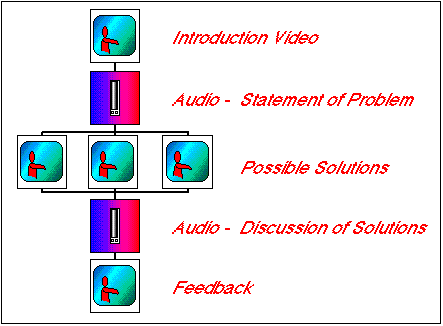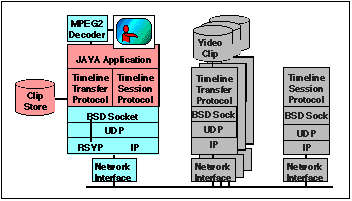
The TimeLine Protocol
The TimeLine protocol provides the means of distributing multimedia information
(including MPEG-2 encoded video clips) to the clients in the MediCAL
project. The server protocol executes on SUN workstations, and clients are
provided for PCs under NT and SUN workstations.

The protocol is designed to optimise transfer when a group of students
in a classrroom view one from a number of CAL sessions. A typical multimedia
session will consist of a sequence of video clips (each of approx. 10 minutes
duration), separated by audio commentries (often accompanied by a still
image). Each student is free to choose their own path through the presented
material - but all syudents are encouraged to view all the material at least
once.

The Timeline protocol provides the following benefits, when compared
to traditional file transfer protocols:
- Low Overhead (Application Layer Framing)
- Transmission Scheduling
- Rate Control
- Scalable Reliability
- Multicast Capability
Brief Description of Protocol
The protocol has two components:
- Session Protocol - This coordinates the transfer of files from the
server, each client indicates to the session server the video clips in
which it has an interest, and the estimated time at which the clip will
be needed. This indication is provided in a Session Request. The
session client provides this information periodically to the session server.
The session server executes from time-to-time to collect infromation from
all clients and processes session requests to determine the order of transmission.
- Transfer Protocol - Each client also runs one or more client processes
for reception of files containing the required multimedia information.
The clients receive the data from a transfer server, which is started through
a Transfer Request from the associated session server. There is
one transfer server for each file being sent. Different transfer servers
may coexist on the same hardware platform, or be distributed between a
number of platforms. A transfer server maintains no data concerning the
group of clients to which it may be communicating, it simply follows the
instruction of the session server. The foile is sent as a sequence of Data
packets. Should packets from a transfer be lost (by the server, network
or (most probably) the client), the client assumes responsibility for requesteing
repair of the file by sending a Repair Request to the Transfer Server.

The client part of the timeline system executes under either NT on a
PC platform or under Solaris on a SUN platform.

The server part of the timeline system executes under only Solaris on
a SUN platform.

The operation of the protocols is summarised in the following
diagram, which shows a single file being sent to a single client.








